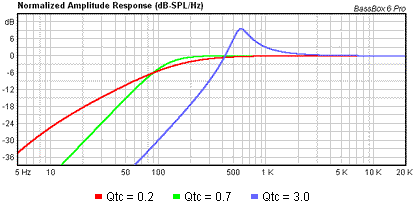Maths and theory applied competently get circuit values in the right ball-park. In this case, I’d experiment for best results. For example, the speaker will be most efficient when the electrical resonance is tuned to its mechanical resonance. However, this could be too much for the construction, as when opera singers shatter wine glasses! A cheap speaker rated for 1W with a normal audio spectrum, might not be able to sustain that promise at resonance. (More expensive speakers are designed to avoid resonances within their operating range because resonances disturb music lovers. Done by reducing speaker efficiency, which is why I suggested a ceramic disc. They go for maximum efficiency at a particular tone, producing a nasty waveform that’s very loud!
Beware: I often get maths wrong, and haven’t tested my conclusions by wiring one up!
Dave
I’ve been majorly misinterpreted!
I suggest Dave you look at en.wikipedia.org/wiki/Thiele/Small_parameters and download WinISD.
For most speakers, the resonant frequency is effectively their low-frequency cut-off, below which the speaker becomes less efficient. You can’t avoid the resonance of the driver, it’s an inherent property of the driver. What you do is tune the enclosure (either by choosing a specific volume or making it into a tuned cavity by using one or more ports) to flatten out the resonant peak into an extended bass response. …
Below in the blue example the resonance at 600Hz could cause problems (Qtc is the inverse of the damping ratio i.e. a measure of resonance).
The green line is an ‘ideal’ response for a flat response speaker.
The red line is over-extended so you don’t get any useful extension compared to the green line.

…
Not misinterpreted, rather Neil and I are at cross-purposes.
I was tightly focussed on the electronic aspect of Duncan’s question : how to drive a 1W 8Ω speaker with a square wave. Nothing HiFi about Duncan’s requirement – his application is an alarm, where loud and piercing are the bees knees, not bass response.
Neil’s comments address a different aspect of loudspeaker design – how best to enclose the mechanical speaker. The box a speaker is mounted in is important too, especially when playing music. But this is acoustics rather than electronics. Acoustic engineering also deals with the resonance and distortion of waveforms, but they’re sound waves moving in air. And it’s complicated – the speaker and its enclosure have to be optimised, and then – ideally – the room matched to the speaker. Thought the Sydney Opera House has a striking exterior, I’m more impressed by the audio performance of its interior.
Anyone else remember the good old days at Paddington, where announcements sounded like: ‘The tra, tra, ain, now ow ow, st, st, anding a at Pla, pla t form, rm, two oo oo is the nu nu ine ten for Ca ca ard if if’. This was the best a 1930 PA system and horn speakers could do in a big echoing building without spending a fortune!
HiFi takes engineering design into complicated territory. In Neil’s bass guitar, the pick-up will have been designed to produce a flat response over the range of tones produced by the strings, and although it will also do a good job with overtones and harmonics, higher pitched guitars are probably fitted with pick ups that suit their frequency range. These pick-ups need to be accurate rather than efficient, because low signals are easily amplified electronically.
The signal is normally fed into a pre-amplifier, designed with a flat response to increase the signal level without distorting it. The output could be fed directly into a power amplifier, but more likely there will be a processing stage. The processing could be as simple as a Tone control, or a basic graphic equaliser, or an advanced graphic equaliser plus other gizmos. The purpose, in so far as possible, is to compensate electronically for shortcomings in the pick-up, amplifiers, and loud speaker system.
In my youth, audio systems were entirely analogue. Worked well if a lot of money was spent on them, but with many limitations, and they were noisy and tended to sound a little mushy or other wise tainted compared with live music. Filtering is particularly difficult to do well with analogue components, for example a sharply tuned high-Q inductor/capacitor combination rings like a bell because the components store energy. The filter has to be backed off to avoid ringing, not good.
Digital processing is much better at cleaning up and manipulating signals than analogue. The signal is converted into a stream of numbers that can manipulated mathematically. Implementing a digital filter that doesn’t ring no matter how sharply tuned is trivial. A bit code like:
getInput:
read sample
if sample < 999.9 or sample > 1000.1 then goto getInput
And much, much more can be done. See Cher Effect which was a novel use of Autotune – a device that corrects off key singers on the fly, so what reaches the speaker is correct.
Fascinating stuff and worthy of long discussion, but a long way from Duncan’s requirement, which is how to make an Arduino make a nasty noise as an alarm!
Dave
duncan webster 1.










